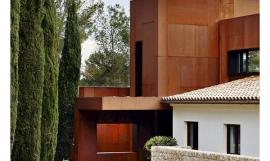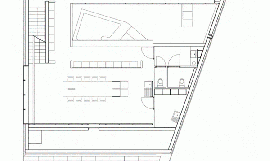• 由Sherin Wing发布
• 美国,波特兰州立大学,ArchDaily,教育类,学校建筑指南
• by Sherin Wing
• ArchDaily College GuideArchitecture EducationPortland Portland State University USA
如何获得社会公正?波特兰州立大学建筑学院(Portland State University School of Architecture)的学院和学生都在以不同的形式探索这个问题。通常,当人们想起波特兰或俄勒冈州(Oregon)时,“环保”和生态“猛士”的意象总会浮现在人们的脑海中。但这些问题不只代表一种生活方式或消费选择,而是当讨论人们和生态的问题时,问题围绕的是资源。具体来说,也就是人们怎样利用和分配资源,以促进公平、良好的资源分布,而不是开发、压榨和铺张浪费。
为此,建筑学院刚刚落成公共利益设计(Public Interest Design)的新中心。用董事Sergio Palleroni的话来讲,就是倡议努力实现“革命性的系统变化”这些解决方案和干预措施不只依靠设计头脑的想象力或创新思维,而是依靠依靠研究“调查最优的新兴实践模式,参与式研究客户社区的贡献和每个地方独特的社会、政治和经济条件——同时尽可能利用地球的有限资源。”这潜在为社会参与提供了重要模板,这种模板植根于文化、人口和历史研究,而不是仅仅应用浅显的空间设置。”
该项目来自教师、学生、和行业之间以研究为基础的合作,最终形成SAGE教室,是为了学校需要更多教室空间而提供了模块化、成本效益和生态环保的选择。旨在采用环保、可再生的建筑材料建造教室,为教师和学生提供更健康的环境,同时在整个施工过程中节约资源。更重要的是,其初始投资成本略多于传统的教室结构施工。
该项目理想地结合了精确的研究方法和国内外项目的文化因素。对于公共利益设计中心,它们的第一个国际项目是将其思想和技能传递给蒙特西诺斯孤儿院(Montesinos Orphanage)和海地的环境技术学校(Environmental Technical School)。该项目的客户为孩子们。基于他们和教区神父的需要和观点,该设计解决了诸如供水系统和预防地震等问题,在30英亩的土地上造了一栋“已落成的容纳160名学生的学校和宿舍,我们现在的重点是设计建造一家面包店、供水系统、有机农场和复建工作”。
Social justice. How can that be achieved? At Portland State University School of Architecture, faculty and students are exploring just this issue in different forms. Often when people think of Portland or the state of Oregon, images of “crunchy” eco-“warriors” come to mind, but these issues are not simply proxies for a lifestyle or consumer choices. Rather, when discussing people and ecology, the issues are about resources. Specifically, how do humans use and allocate resources to promote fair, well-distributed advancements rather than exploitation, oppression and conspicuous consumption.
Towards that end, the School of Architecture has just inaugurated the new Center for Public Interest Design, an initiative that is working towards “making transformative and systemic change,” in the words of Director Sergio Palleroni. These solutions and interventions rely not just on the imagination or innovation of design minds, but on research “that investigates the best of these emerging models of practice, and participatory action research that accounts for the contribution of client communities and the unique social, political and economic conditions of each place—while making the best use of our planet’s limited resources.” This can potentially offer an important template for social involvement, one that is rooted in cultural, demographic, and historical research rather than merely applying a superficial spatial approach.
One project that resulted from this research-based collaboration between teachers, students, and industry is the SAGE Classroom, a modular, cost-effective and ecologically responsible option for schools that require more classroom space. The aim is to use responsible, renewable construction materials to construct a classroom that provides a healthier environment for teachers and students while conserving energy over the lifetime of the structure. What’s more, the initial cost is slightly more than a conventional classroom structure.
Combining a measured, well-researched methodology to cultural engagement ideally includes both domestic and international projects. For the Center for Public Interest Design, their first international project is to add their thoughts and skills to the Montesinos Orphanage and Environmental Technical School in Haiti. Based on the needs and vision of the parish priest and the children who are the clients of the project, this proposal addresses issues like water systems and seismic activity to produce a “school and dormitories for 160 students [that] have been completed, and we are [now] focusing design and construction of a bakery, water systems, organic farm, and restoration” on the 30-acre site.

另一个用于研究学习的有趣的地方就是沙特克大厅生态学习中心(Shattuck Hall Ecological Learning Plaza)。这是一个也以公共方式探索不同的“可持续建筑的实践方案”的实验室。因此,这不仅是一个向公众开放的实验室,也是一个为向公展现技术和创新的场所。同时,学生们可以发现建筑设计如何以不同的建筑功能影响基础设施。例如,目前,此两个年度的项目就是关于活动的墙壁可以拥有视觉享受的同时,提供诸如管理雨水等问题的信息。
学生可以报考本科,但实际上学历是学前教育专业,将获得建筑专业的B.A.或B.S.的学位。研究生学位是一个为期两年的建筑学硕士。无论是本科还是研究生,学生都可以充分利用研究中心和实验室提供的,以研究为基础的有趣的机会。学院包括30多名全、兼职教师指导200多名学生。本地本科生和研究生的学费分别约为1974.00美元和4954.00美元。非本地的学生学费较贵,分别约为7154.00美元和7860.00美元。通常学生也可以申请奖学金。
Another interesting venue for investigative learning is the Shattuck Hall Ecological Learning Plaza, a laboratory that explores different “sustainable building practices” in a manner that also engages the public. Therefore, not only is the lab open to the public, but it provides a site for demonstrating technology and innovations to the public. Students simultaneously discover how design can function differently to affect infrastructure. For example, the current two year project is about living walls that can be enjoyed visually while simultaneously providing information about issues like managing storm water.
Students can attend as undergraduates, however the degree is actually pre-professional and will be attained as either a B.A. or B.S. with a major in Architecture. The graduate degree is a two-year M.Arch. In both, one can take advantage of the interesting research-based opportunities provided by the centers and laboratories. Faculty includes over 30 full- and part-time faculty to instruct over 200 students. Tuition is approximately $1974.00 and $4954.00 for resident undergraduates and graduate students, respectively. Non-residents pay considerably more, at $7154.00 and $7860.00 for undergraduate and graduate students.General scholarships are available, as well.
特别鸣谢翻译一组10号 张晓丽 提供的翻译,译稿版权归译者所有,转载请注出明处。 |
|

 Dexia / Atelier Pierre Hebbelinck工作室/Dexia / Atelier Pierre Hebbelinck
Dexia / Atelier Pierre Hebbelinck工作室/Dexia / Atelier Pierre Hebbelinck
